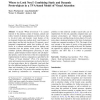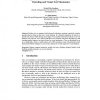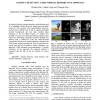129
Voted
ICASSP
2011
IEEE
14 years 4 months ago
2011
IEEE
Selective attention in the human visual system is performed as the way that humans focus on the most important parts when observing a visual scene. Many bottom-up computational mo...
113
Voted
COGCOM
2010
14 years 10 months ago
2010
To decide ``Where to look next ?'' is a central function of the attention system of humans, animals and robots. Control of attention depends on three factors, that is, lo...
143
Voted
HCI
2009
14 years 10 months ago
2009
This contribution presents our work towards a system that autonomously guides the user's visual attention on important information (e.g., traffic situation or in-car system st...
120
Voted
HCI
2009
14 years 10 months ago
2009
Touchscreens are becoming the preferred input device in a growing number of applications. They are interesting devices which are more and more introduced into the automotive domain...
113
Voted
JUCS
2010
14 years 11 months ago
2010
: Modern cars are equipped with advanced technology requiring cognitively complex operation that is reliant on the user’s visual attention. It is therefore hazardous for drivers ...
125
Voted
ICMCS
2010
IEEE
14 years 11 months ago
2010
IEEE
In saliency detection, regions attracting visual attention need to be highlighted while effectively suppressing non-salient regions for the semantic scene understanding. However, ...
129
Voted
IJCV
2007
15 years 3 days ago
2007
Robots often incorporate computational models of visual attention to streamline processing. Even though the number of visual attention systems employed on robots has increased dram...
82
Voted
COGSCI
2004
15 years 12 days ago
2004
Change blindness provides a new technique for mapping visual attention with unprecedented spatial and temporal resolution. Change blindness can occur when a brief full-field blank...
97
Voted
TVCG
2008
15 years 13 days ago
2008
Artists, illustrators, photographers, and cinematographers have long used the principles of contrast and composition to guide visual attention. In this paper, we introduce geometry...
107
Voted
PRL
2006
15 years 15 days ago
2006
A new computational model for active visual attention is introduced in this paper. The method extracts motion and shape features from video image sequences, and integrates these f...



